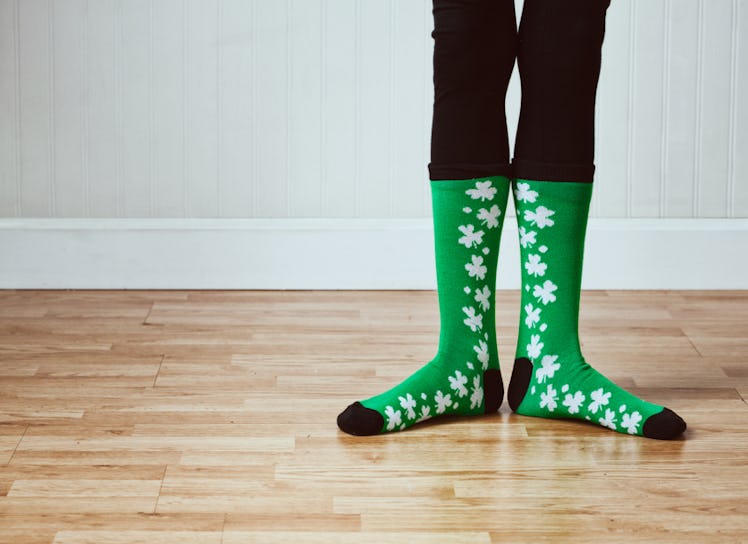
This Is Why We Wear Green For St. Patrick's Day, But It's Not The Only Festive Color
There are very few rules to follow on St. Patrick's Day, but the select few guidelines for the holiday are practically mandatory: You have to be cool with leprechauns, down for some beer with food dye in it, and you absolutely need to wear green. But why do people wear green on St. Patrick's Day in the first place? It's obviously associated with Ireland, but what about orange and white, the other central colors on the Irish flag? Why is it all or nothing with that emerald hue?
I'm not going to lie, I thought this question was pretty straightforward when I began my research. Little did I know, though, that the history of St. Patrick's Day has a whole lot to do with politics and leprechauns, and I can't even decide which one is more interesting.
Politically, the history of wearing green is directly connected to the series of revolutions that took place in Ireland in opposition to the English crown, starting in the 1600s. According to TIME, the importance of the color green was one directly related to Irish nationality and desires for independence. But green wasn't always the native symbolic color of Ireland.
Before the revolutions, blue was the main symbolic color of Ireland, and light blue was the official color of St. Patrick.
Can you imagine how different St. Patrick's Day would be if we all had to wear blue? Chicago wouldn't have to spend all of that money on dying its river green — but hey, that's part of the fun.
The politics of changing the national color to green may have been a sign of Irish attempts at independence, but it wasn't the entire country that wore green. In fact, colors were split down the middle, depending on what religion you were: If you were Catholic, you wore green to represent your Irish heritage, and if you were Protestant, you wore orange.
So, when you're celebrating St. Patrick's Day, you're not just celebrating an Irish holiday, but a holiday with customs and traditions that have been shaped more specifically by the Irish Catholic culture. (And if you really want to get into your Protestant heritage, you could don an all-orange outfit to educate all of your friends on the history of Ireland.)
But if you go even farther back into Irish-American history, wearing green was supposedly all about hiding from leprechauns.
Yep, that's right. The most fantastic reason for why Irish-American people wore green for St. Patrick's Day has nothing to do with politics or religion, and everything to do with those creepy, magical men wearing buckled top hats at the end of a rainbow.
According to The Christian Science Monitor, in the early 1700s, Irish-Americans supposedly bought into the folklore that wearing green would make you invisible to leprechauns, who were apparently creatures they thought you needed to hide from. If you didn't wear green, a fairy or leprechaun might pinch you, so the legend goes. As a part of the St. Patrick's Day tradition, people would pinch anyone who wasn't wearing green, as a reminder of the leprechauns lurking around.
This, in my opinion, is the absolute best reason to wear green. Who doesn't kind-of-low-key wish we lived in a world where we genuinely lived in fear of a little pinch by an invisible leprechaun? OK, maybe that wouldn't be as fun as it sounds, but it's still exciting to have a reason to wear green that's grounded in magic and fairytale lore.
Of course, if you don't own a lot of green, that doesn't mean you can't celebrate St. Patrick's Day accordingly. The only non-negotiable rule for St. Patrick's Day is to enjoy yourself, in whatever way you see fit. I think that's how the leprechauns would want it to be.